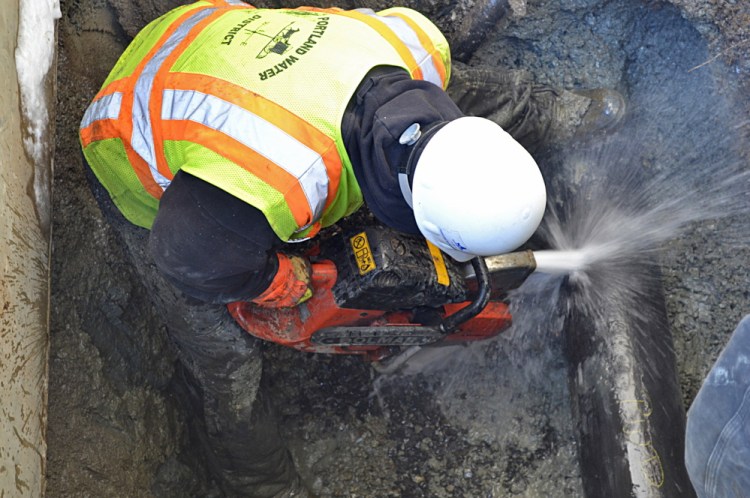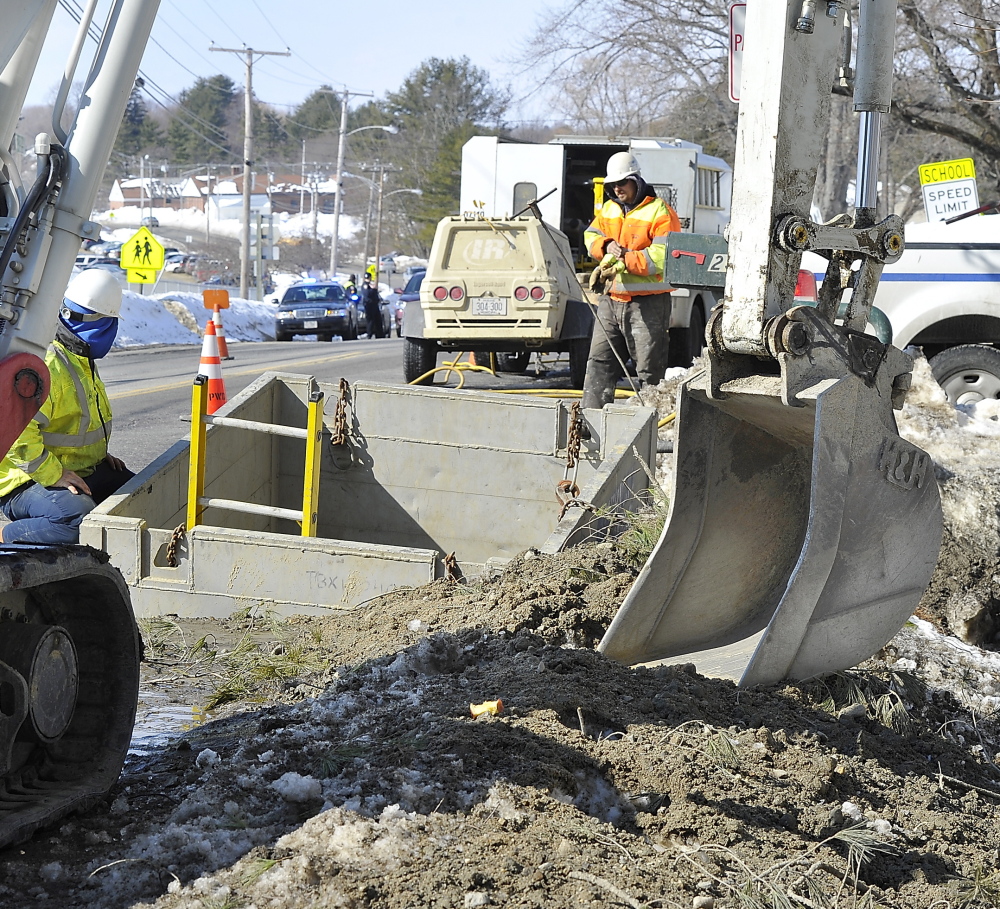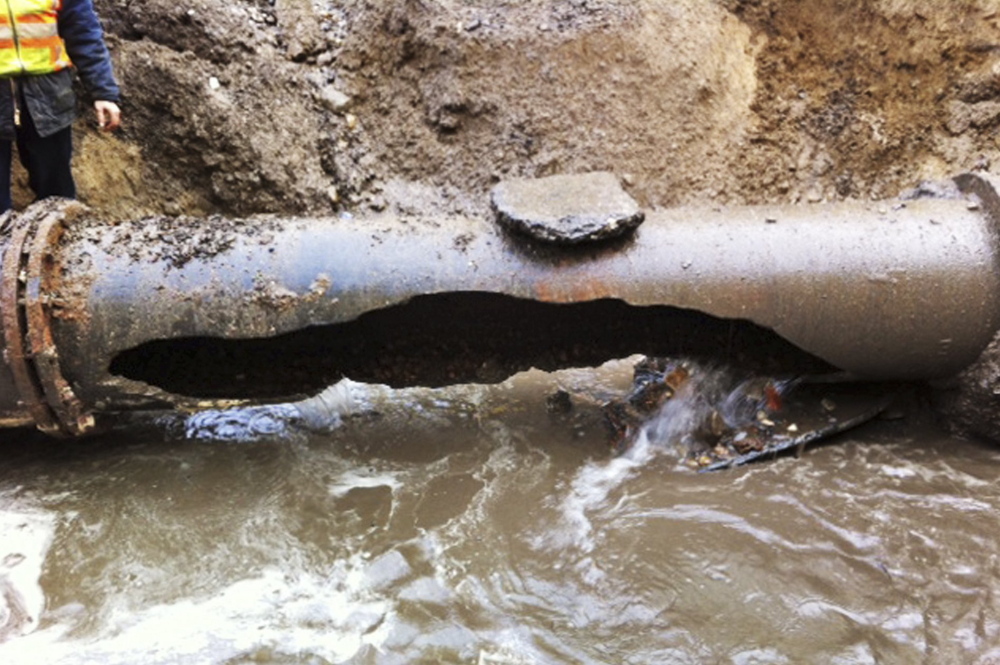February’s historic cold drove frost deep into the soil where the Portland Water District’s water mains are buried, wreaking havoc on the utility’s aging infrastructure.
“The frost went down into the ground almost 4½ feet,” said Chris Crovo, director of asset management and planning for the water district. Most of the district’s water mains are 5 to 5½ feet deep, though sometimes shallower because of ledge, Crovo said.
“That frost moves the pipe and some of that pipe is old, cast iron and brittle. It doesn’t hold up very well, and it cracks and leaks,” he said.
In the latest break, district crews replaced a section of cast iron pipe after a main ruptured Monday on Stroudwater Street in Westbrook.
The district had 21 water main breaks in February, twice the normal number for a winter month and the most in any February since 2004, said district spokeswoman Michelle Clements. January had a more typical eight to 10 breaks, she said.
The water mains haven’t been the only casualties of the frigid weather. The deep snow and heavy ice also have taken a toll on natural gas and propane equipment.
Last week, the Portland Fire Department responded to a business on Marginal Way after its natural gas line was ruptured by a snow plow. The Portland Museum of Art and the Children’s Museum & Theatre of Maine had to be evacuated after a falling icicle punctured a gas line.
In Cape Elizabeth on Monday, a propane line at 146 Scott Dyer Road was severed by a buildup of ice and snow, sending the gas into the home and resulting in an explosion and fire, the State Fire Marshal’s Office said. Also Monday, a business at 470 Riverside Street in Portland filled with gas after a service line broke under a deep pile of snow.
Since Jan. 1, the Portland Fire Department has responded to 21 gas leaks, two more than in the same period last year, said spokesman Tim Nangle.
CERTAIN PIPES MORE VULNERABLE
The water distribution system has had a more difficult time with the weather.
That’s because about 460 miles of the district’s 1,000 miles of pipe are cast iron and range from 100 to 140 years old, with some dating to 1870, Crovo said. The cast iron is being replaced with newer, ductile iron pipe, which flexes and doesn’t crack as easily.
The water mains are vulnerable because they are buried beneath the street, where plow crews have scraped away any insulating snow.
The service lines running to customers’ homes are less prone to breaking because the thick snow cover serves as insulation. Some service lines have frozen, but that has typically been because the pipe is closer to the surface or is near a stormwater collection system pipe that allows cold air close to the service pipe.
The sewer system is not susceptible because those pipes are warmer and the system is more modern.
The water line problems are not unique to Portland. Lewiston Public Works Director David Jones told WCSH6-TV that his city is seeing more water main breaks, and cold weather is to blame.
A water line break in Lewiston closed part of Ferry Road for several hours Monday.
MANY STEPS IN REPAIRING PIPES
Water leaks can be difficult to find because the water doesn’t always bubble to the surface above where the leak is located. The frost can form a barrier and force the leaking water to migrate to another spot before it works its way to the surface. Sometimes the district has to drill test holes to locate a leak. That leaves the water running, which causes icing on the roads.
Once a leak is located, each water line repair requires extensive excavation, often disrupting traffic as roads are closed or narrowed. Workers use a jackhammer tip mounted on an excavator to break through the frost layer, Crovo said.
“It’s like going through ledge,” he said.
Once the pipe is excavated, the broken section is examined. If it has a radial crack, it is patched with a “Band-Aid.” If it has a lateral crack, a section of old pipe must be cut away and replaced with a new one. That was the case Monday in Westbrook, where 3 to 4 feet of cast iron pipe had to be cut away and replaced.
When the repair is finished, the hole is filled with gravel, and even that is complicated by the weather. The gravel needs to be dry and not frozen into large chunks. Crews then place an asphalt patch over the gravel, waiting till the warmer months to repave it properly.
MORE SPENDING, SPRING BREAKS NEXT
Portland’s water district is gradually replacing its oldest pipes.
The district spent $6 million on replacing pipes last year, budgeted $6.5 million for this year and is asking for a 3.8 percent revenue increase so it can increase the replacement fund to $7 million annually, said Clements, the water district spokeswoman. In 2011, the district was spending just $2.5 million annually on pipe replacement.
The district tries to anticipate problem areas and make them a priority, Crovo said.
“If we get multiple leaks on a road, it tells us that pipe has met its useful life,” he said.
Crovo said that although it seems like Greater Portland has had more than its share of water main breaks this winter, the American Waterworks Association’s benchmark is 25 to 30 breaks a year for every 100 miles of pipe. The water district averages about 10 per year for each hundred miles of pipe, Crovo said.
February’s deep freeze also could create problems this spring, he said.
“Frost receding is also not good for water pipes,” Crovo said. “Probably the last two weeks of March we’ll see another rash of breaks.”
However, the infrastructure that most people will be paying attention to at that point will be the roads.
“They’re going to have a banner year for potholes,” he said.
This story was updated at 9:10 a.m., March 3, to correct the number of miles of pipe used in the benchmark for the American Waterworks Association.
Send questions/comments to the editors.





Success. Please wait for the page to reload. If the page does not reload within 5 seconds, please refresh the page.
Enter your email and password to access comments.
Hi, to comment on stories you must . This profile is in addition to your subscription and website login.
Already have a commenting profile? .
Invalid username/password.
Please check your email to confirm and complete your registration.
Only subscribers are eligible to post comments. Please subscribe or login first for digital access. Here’s why.
Use the form below to reset your password. When you've submitted your account email, we will send an email with a reset code.